Making ze poured fondant
Traditionally, poured fondant was made by making a dense sugar syrup, then stirring it over a period of about half an hour until it turned into fondant. Fortunately, the modern age brought us the food processor, which made things much easier. The new standard poured fondant recipe goes like this: 2 1/2 cups (17.5 ounces) sugar, 1/2 cup (4 ounces) water and 1/4 cup (3 ounces) corn syrup. Combine that in a small sauce pan and heat it to 238 degrees.

As soon as the syrup hits 238, pour it into the bowl of your food processor and immediately…wait.

…for about half an hour until the temperature of the syrup drops to 140.
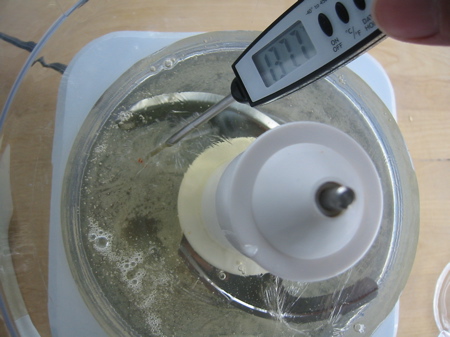
At that point turn on your processor and leave it on. The syrup will at first turn a slightly translucent yellow…
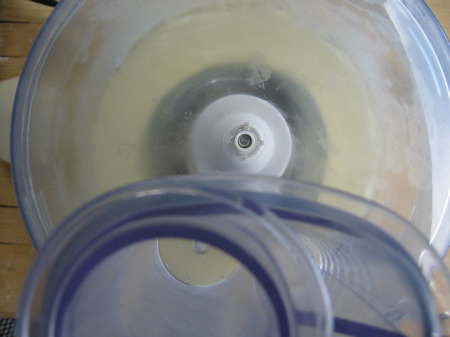
…before finally turning white. This will take only about two minutes.
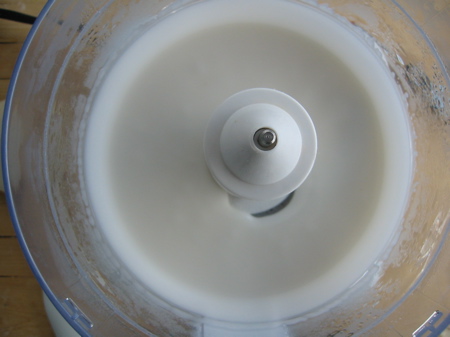
Promptly pour the fondant into a quart-sized Ziploc bag, conveniently stretched over the mouth of a glass measure.
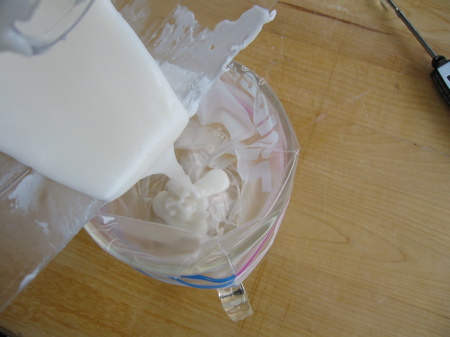
Let it sit until it’s cooled. At which point all you do is squeeze the air out of the top of the bag and seal it.
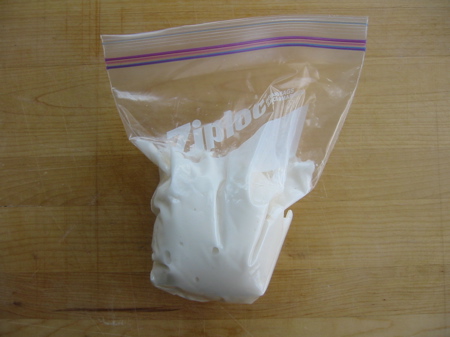
And voilà, a batch of poured fondant. Doesn’t look very “pourable” does it? In fact it’s hard as a rock (well, almost). That’s because you have to warm it and dilute it with a 2-1 sugar-water syrup before you can use it (but more on that soon). You can use it immediately or keep it (ideally in the fridge or even freezer) for up to a year.
Applying Ze Poured Fondant
So what do you do with this sugar putty once you’ve made it? Great question. To use it you need to melt it but since it hardens rather quickly as it cools it’s not easy to work with in its unadulterated state. That’s why we’ll need to dilute it. Slightly.
The easiest way to gently melt poured fondant is in a double boiler. This is a full batch, about 20 ounces.
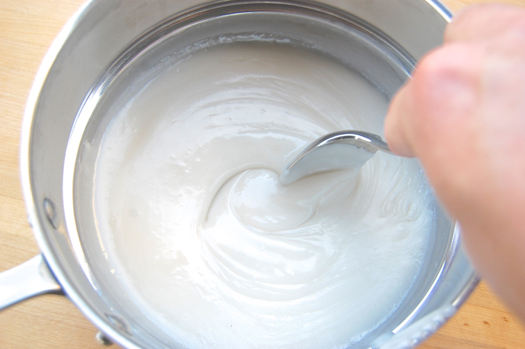
To make it spreadable and to keep it loose enough so we can make a design in it — for Napoleons or Esterházy torte — we’ll add very, very little water. The reason: because just a little water can make quite a lot of syrup. I find that 3 1/2 teaspoons is about perfect for 1 batch (20 ounces) of poured fondant.
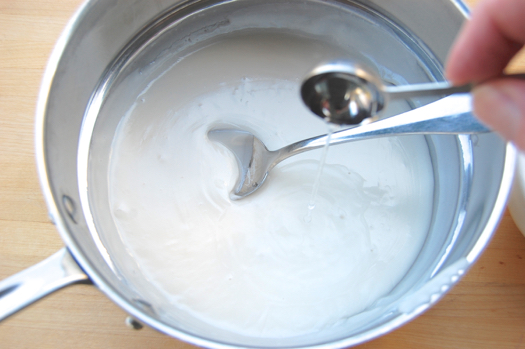
After the water has been added to the melted fondant, stir it while it cools down, since you don’t want a skin to form. You want it to come down more or less to room temperature. Why? Because very often there’s layer of jam under poured fondant and we don’t want it to melt when we apply the fondant, because that’s a mess.
So, when the fondant feels almost completely non-warm it’s time to apply it. Here I’ll do a design for Esterházy torte. I pour on about a cup of the diluted fondant.
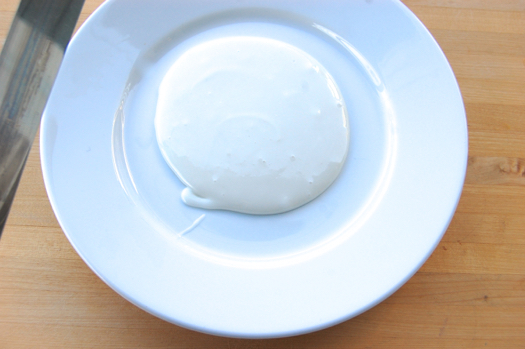
The I spread it around with an icing spatula. At this point it seems like the fondant is too thick since I can see ridges after I spread it. But if I wait ten seconds or so the fondant will slowly settle to a smooth layer with rounded edges, at which point it’s ready for the melted chocolate or ganache.
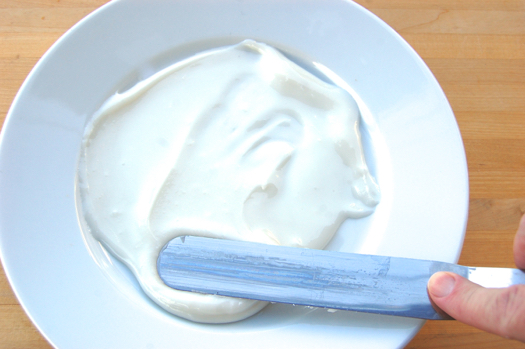
I make some concentric circles…

…then drag a toothpick outward…

…inward…
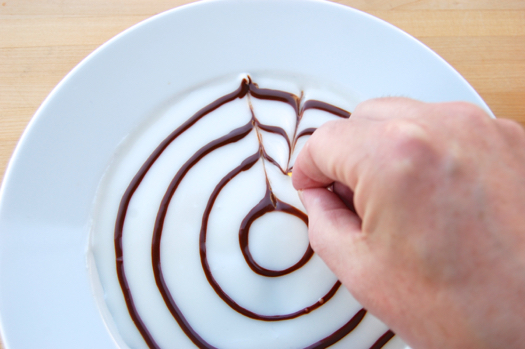
…outward and so on…

…all the way around.
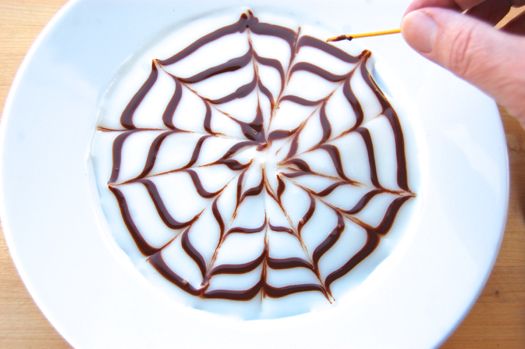
I should note that it generally helps to avoid spreading poured fondant all the way out to the edge of what you’re coating since you’ll get very slow spread for the next minute or so. If you can avoid letting the firming fondant flow over the edge of your pastry it’s desirable since the falling icing with stretch out whatever shape you just created. It will be fully set up after about 15 minutes.
Dear Joe,
I want to use poured fondant to glaze sugar cookies. I want to clarify the simple syrup recipe you gave “2-1 water to sugar” for diluting the poured fondant. Did you really mean 2 parts sugar and 1 part water? I search another site for simple syrup recipe and found it was a ratio of more water than sugar (one being 3 parts water and 1 part sugar. Is the recipe for your poured fondant the best for icing cookies? Please clarify. Thank you so much!
Hello Ahn…I actually meant 2 parts water to 1 part sugar. That a proportion that will give you the result you’re after!
Thank you so much for your reply Joe. I need a little more clarification about the measurement portions for simple syrup. I read your instructions about making cake syrup and you said the parts of these ingredients should be measured by weight like 6ozs of water to 3ozs of sugar. Is that the standard for measuring these ingredients? I wondered at times if it meant like 2 “cups” water to 1 “cup” sugar. It is confusing to me at times because liquid and dry ingredients are measured differently. Thank you, again, and I love your website!
I generally measure everything by weight, so, 2-1 water-to-sugar means, for example, 200 grams water added to 100 grams sugar. I understand that’s a little odd, which is why I usually use more precise measurements. Sorry for the confusion!
Joe,
I tried making the poured fondant last night but I ran into a problem. After I waited for the temp to come down to 140 I turned on the processor as directed. The processor rotated a few times before it got stuck in what turned out to be a bowl full of completely hardened sugar. What did I do wrong?
Wow…that’s amazing. I’m not sure. How big is your food processor if you don’t mind my asking? Is it a small chopper-sort-of-thing? I ask because if you’re certain the syrup temperature was 140, something caused that motor to stop. I wonder what it was? Hmm…
Hi Joe,
In making the poured fondant, you stated that we should warm it and dilute it with a 2-1 sugar-water syrup before we can use it. If we want to use it immediately right after making the fondant, do we have to carry out this step?
May I also ask if this is the type of fondant with which eclairs are coated with?
Thank you.
Hi Alex! As long as the fondant is warm it will pour pretty well. The problem with undiluted fondant is that it hardens very quickly. The syrup buys you a little time to pour and spread the stuff before it forms a skin and starts cracking. So I suggest using at least a little.
Concerning éclairs, they’re usually just crowned with a little melted chocolate. However I can imagine that somebody, somewhere has topped them with fondant.
Thanks for the email!
– Joe
I attempted to make poured fondant but ran into a problem – when heated (although I will admit there was too much heat), it just turned into a simple syrup. But I can’t help think that maybe something was screwed up at the beginning: when I was grocery shopping I asked my husband to turn on the cooled fondant for two minutes, showing him what the fondant should look like within 2 minutes. He texted me to say that it took more than 10 minutes to get the white color – could it have been over processed? Also, how long does simple syrup take to make?
On a lighter note, the marzipan and genoise cake came out perfectly! Thank you!
Hi Jaime!
Glad to hear about the marzipan and the génoise, though of course the fondant issue is a bit of a downer. If in truth it did get very hot (instead of merely warm) the crystals would have melted and the whole thing would indeed have simply reduced to syrup. I’ll make a note about that in the recipe…do not boil or simmer.
Is it too late to try again? Sorry for the bad results!
– Joe
Hi Joe,
I’m a pretty experienced home baker, and followed the recipe exactly. Anyhow, even when completely cooled mine did not turn out solid. It is still liquidy. 🙁
Any thoughts? What went wrong? Can I still use this as a base for a glaze? I am wanting to use it as a base for fondant glaze for religieuse. The recipe is something like:
4oz pouring fondant
3oz melted white choc
Flavoring such as pistachio paste or coffee or fresh raspberry coils or
etc.
Thank u!! Awesome website!!
Very sorry to hear that, Melissa! I’m sure we can figure out what went wrong. First, how much syrup did you add to it?
Dear,
Can I replace corn syrup by anything else? I can not find corn syrup in my country.
Hello Annie!
You can make something equivalent to corn syrup like this:
16 ounces water
2 lbs, 10 ounces sugar
1 teaspoon cream of tartar
Combine all of the ingredients in the saucepan and stir until the sugar is completely moistened. Clip the candy thermometer to the side of the pan and set the pan over high heat. Do not stir the sugar after this point.
Boil the syrup until it just barely reaches a temperature of 240° Fahrenheit. Immediately turn off the heat, remove the thermometer, and move the pan to a cool spot on the stove or a cooling rack. Allow the syrup to sit undisturbed until it has cooled completely, at least an hour.
Best of luck!
– Joe
Hi Joe,
Your site is great!
I was hoping for some advice. I attempted the first stage of this fondant tonight, but within less than 30 seconds of processing, the sugar mixture was already white and starting to harden. Did it just cool too much or is it ruined? I’ve put it in a bag to potentially use over the weekend, but would I be better starting again from scratch?
Thanks in advance for your help!
Ellen.
Hi Ellen!
It sounds to me like you’re in good shape. If the temperatures were correct before you started processing, everything should be good! Have fun and let me know how it goes!
– Joe
I do a chocolate fondant to coat my eclair, my recipe for the fondant is commercial fondant + chocolate coin +water, it can be running but to the next day , it became crystallisation how to prevent this problem, and how to retrieve it to the running state?
Hello Ong!
You can try adding a little glucose or corn syrup to the mixture to prevent the crystallization. Otherwise my best suggestion is to re-melt it once it firms to make it pourable.
Cheers,
– Joe
What fun. You seem to turn up in my searches lately. 🙂 I dipped sugar cookies in poured fondant tonight and thought I’d see what others were doing. I’ve happened upon you several times lately.
Clearly we were destined to meet, Cheryl! Thanks for the note and come back often!
– Joe
Thank you for your site and your work! “making ze poured fondant” is still not linked to the black and whites, though. Never mind! I finally have a use for a food processor. Of course, I no longer have a real food processor. I do have a super powerful blender and I’ll try that.
When I still lived in NYC, after retiring as a pastry chef, I was able to walk to the nearest pastry shop and convince them to sell me a few pounds of the commercial fondant. The only way I knew to make it myself was the old way: pour the hot syrup on a marble slab and work it by hand.
Here are some fondant tricks:
1) Reheat it in a stainless steel pan mixing with your hand right in it. When the bottom of the pan gets too hot to touch, take it off the fire, stirring constantly. Move back and forth over the heat with one hand in the pot, adding only a little syrup if necessary, until the temperature is 110 (comfortably warm) thoughout and the consistency is right for pouring. The faster and more the icing is worked, the shinier the finished product. Raw egg whites work even better than syrup.
2)When making marzipan from almond paste, use fondant instead of glucose or corn syrup. The marzipan will be whiter.
Fabulous, Amy! And what terrific tips! Who knew working the fondant produced a shinier coat? I’m going to try that in the very near future as I still have some fondant sitting around. Nice marzipan tip as well!
Thanks very much for checking in and I’ll put a link in soon!
Cheers,
– Joe
Hi.
I came across your website when searching for a recipe about making poured fondant. Here in Finland we call it ‘pomada’, though, but it is the same sticky stuff.
Your recipe seemed very promising and as I tried making it, every promise was fulfilled! My batch was perfect!
It’s important not to stir the mixture as it is boiling to prevent any crystals forming to the edges of the pan. I let mine cool in the same pan I boiled it in and just let it sit, untouched (very important not to touch it while cooling, btw) and used a hand-mixer to beat it white and fluffy.
Thank you so much for sharing your recipe with us! It was super-easy to follow and very informative.
With best wishes, Pia
Hello Pia!
Thank you very much for the delightful note. I’m so glad it turned out well for you. Please come back — and keep me updated on your baking adventures!
– Joe
I make fondant using the method described in The Cake Bible. Can I thin that down with sugar syrup to make a pourable fondant?
Hey KF!
You mean watering down rolled fondant to make a pourable one? No, you won’t be able to do that I’m sorry to say. Poured fondant is a candy while rolled fondant is more like a pliable putty. But poured fondant is easy to make!
Best of luck,
– Joe
hi Joe,
I have tried making poured fondant using your recipe, but while i waited the mixture to cooled down to 140, the mixture become hardened. I cant do anything since it was hardened. Please tell me whats wrong. Why my mixture not liquid and thickens like yours.
thanks
Hello Giselle!
You mean to say that it hardened before you had a chance to whip it in the food processor?
– Joe
yes it hardened as soon as i started to whip in the food processor. it became small little rocks.
Pls help me , i wanna make again this morning. thank u so much.
Hello Giselle!
It sounds like a problem with the syrup…like it started to crystallize as soon as it started to cool. Did it come up to temperature do you think? Perhaps there was some sugar on the side of the pan when you went to pour it out. Those are my best guesses at the moment!
– Joe
What are the chances you could make this with maple syrup for a maple fondant or honey, like you can for making Italian meringue?
Hey Jenni!
You could substitute maple syrup for the corn syrup I think, though the fondant would be less flexible and more likely to flake when it cools. A better way to go is to substitute crystalline maple sugar for the regular granulated!
Let me know how it goes if you try it!
– Joe
Hey Joe,
I made this poured fondant recipe and it never got hard for me (as in, before any diluting). I mixed it in the food processor and it got really white, like yours. But, a few hours into cooling, it’s still very liquidy. Maybe something is up with my thermometers, but it looks very much like yours. Any ideas on what I can do? Maybe stir in some powdered sugar? I don’t want to really sweeten it too much more though…
Thanks,
Ilan
Hello Ilan!
So sorry to hear that. It sounds like the syrup temperature didn’t get high enough. If it’s still liquid today then that’s definitely the case: too much water remains in the mixture. You can indeed thicken it by adding powdered sugar. Though the icing will be more inclined to buckle or chip, it’ll still be quite usable.
Better luck on the next attempt!
Cheers,
– Joe
Exciting to find this recipe. I would love to re-create a beloved New York cake that I vaguely remember from childhood as a fluted/bundt-shaped cake, possibly with some ground walnuts in the batter, glazed thinly with raspberry jam (crumb coat no doubt) and covered with semi-transparent white fondant. Would your fondant work for that, or is it opaque once it sets?
Great site btw…
Hi David!
That sounds delicious. This fondant can go on thick and opaque or thin and semi-transparent depending on the degree to which it’s thinned. I should work for your purposes. Let me know how it goes!
– Joe
So I have a recipe that calls for 270 g “Caullet Pouring Fondant” (“Fondant patissier” – see e.g. http://www.frenchfoodexports.com/fondant-patissier-icing-sugar-12313.html). Could I use your Poured Fondant recipe as a substitute? If I did, do you have any idea if I would measure (weigh) before or after diluting? (The recipe is in the Bouchon Bakery cookbook – it’s a Thomas Kellar recipe for homemade Peppermint Patties!) The ingredients appear to be sugar, glucose syrup, and water – your recipe has no glucose syrup (which I gather plays a role similar to corn syrup?); I’m not sure what difference that might make?
Hey Jessica!
This is almost certainly the same stuff, just in a tub. You should be able to use mine interchangeably. Notice how little the dilution is: 5%, it’s gotta be the same thing or nearly so. My suggestion is to experiment with water, start with only 1 teaspoon or so per 10 ounces and see how workable it is. If it seems to tight, add a little more!
Have fun and send pictures!
Cheers,
– Joe
Thanks, I will! The recipe is, as is typical for this book (which is lovely and educational and inspirational, but also deeply intimidating), quite complex – it also calls for Trimoline invert sugar, Fondax (though that is optional, and I’m not quite sure what it is), tempered chocolate, silicone molds, and a dipping fork. I am determined to try it (even though I don’t even like Peppermint Patties that much!). I’m waiting until after the holidays, though, because I happen to know I will be getting a sous vide circulator, and I just saw a great post about tempering chocolate using sous vide – and I have never succeeded in tempering chocolate the other ways. But I figured I’d start gathering ingredients and materials. If I ever succeed, I’ll definitely send pictures! And I intend to use the left over fondant to make black & whites; those have been on my list for a while!
Thank you! 🙂
I have a very stupid question: did you make the sample in a plate just as an example, or after it hardens is it possible to then remove it from a plate and use it as a topper. I want to make a Christmas scene on top of a cake, but as the cake will be frosted with Chantilly cream I need something for the top that can bear weight a bit better.
Hello-
I am just wondering if I can add a clear almond extract for flavoring? I am wanting to do petit fours for a wedding. 🙂 I think the traditional flavor for wedding is almond?
Hello Heather!
Sorry for the late reply but the answer is yes! More traditional is a layer of marzipan on the very tops of the petit fours, but this will work as well!
Cheers,
– Joe